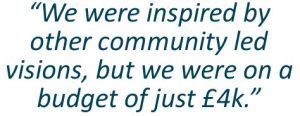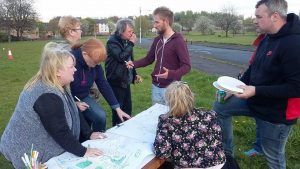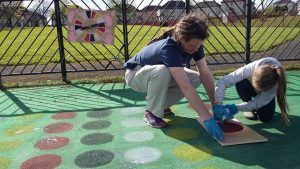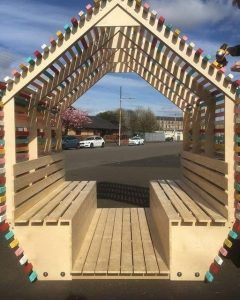As reflected in our 2016 Manifesto for Community Regeneration, the SURF network is keen to see community members engaged more widely in regeneration and planning processes, particularly through meaningfully participatory formats such as Community Charrettes. But Charrettes are expensive; what can be done if the resources to run one simply aren’t available? In this article, Paul Ede, a resident of the deprived Hamiltonhill neighbourhood in north Glasgow, tells SURF about how he helped deliver an impressively creative community visioning exercise on a miniscule budget.
Our Hammyhill was a weekend event that took place in April 2017, designed by local people to develop a community-led vision for Hamiltonhill from the ground up. We wanted to take ownership of our role in the process that has been emerging for some time to put a major development of 600 homes on our doorsteps.
 After more than two decades of feeling like the land and built environment has been razed in front of our eyes, we wanted to explore what a community and spatial plan for our place might look like, by combining the principles from an Asset Based Community Development approach and the values of the Project for Public Spaces at a grassroots level. We have been inspired by other locality plans, and the aspirational (but rarely delivered) vision in high-up policy documents that community and spatial planning should be integrated (and see also here).
After more than two decades of feeling like the land and built environment has been razed in front of our eyes, we wanted to explore what a community and spatial plan for our place might look like, by combining the principles from an Asset Based Community Development approach and the values of the Project for Public Spaces at a grassroots level. We have been inspired by other locality plans, and the aspirational (but rarely delivered) vision in high-up policy documents that community and spatial planning should be integrated (and see also here).
Here, though, we were on a budget… just £4000 from our local Thriving Places pot. But we’ve always been good at being creative on a tight budget round here.
Busy Agenda
We wove everything in to our programme, from community celebrations including a ceilidh and a barbeque to some self-education with a high-profile visiting speaker (we secured Cliff Hague, president of the Cockburn Association for free). We used Clay Church’s Bardowie Hall and open-air sites all over our area. We had an exhibition constructed from insights of local teenagers through the PAS In the Footsteps of Geddes project, using Google Cardboard Virtual Reality technology for panoramic photos and 3D selfie imaging, as well as more traditional Geddesian Valley section work.

Our Hammyhill gatherings were held over a weekend in April 2017
We held a Community-Build with Baxendale out on the street, where local folks could stop, build and chat in a colourful timber-framed moveable viewing platform for community conversations (Geddes’ Head-Heart-Hands came to mind – getting away from plain old maps and concepts), and a play engagement from PEEK where local kids were engaged in play spaces all over the area, asked for their thoughts on community and space while they played.
We also used the Place Standard tool for more formal interviews. We stole an idea from Neilston and distributed leaflets (hand-delivered by locals) with multi-coloured ribbons that could be tied around people’s favourite places in the area in the run up to the event. Not only did this help to publicise the event, but it also helped us to see what the favourite spots already are, and why. We operated a mini-design studio for a central public space after being inspired by Cliff’s ‘Ingredients for Great Public Spaces’ (Urban Design 101) talk. And we imagined, designed and implemented a community-built play-space intervention in one weekend, creating a tree swing, hopscotch and Twister play-space in ‘Hamiltonhill Park’, as our kids are now calling one of our local brownfield sites.
Flow and Purpose
In terms of design, we started with enabling our kids’ vision to emerge and form the heart of the process. Then we thought about what we could do for ourselves on Friday night, taught ourselves what might be possible with Cliff’s help on Saturday afternoon, and only at the end did we begin to think about what we needed other people to do for us.
The goal has been to produce a full-colour brochure with a community and spatial vision for our area so that we as a community can enter discussions about area plans empowered, confident and convinced as to some of the key community goals that we have for our neighbourhood (this brochure is currently in development). Otherwise area plans may be ‘done to us’ rather than ‘with us’; not so if we are all holding our brochures in our hands and (in part) communicating what we have already agreed we want.
Anyway, not bad for £4k. Many Charrettes draw down up to 6-7 times as much from the Scottish Government and often don’t see much greater community engagement. We aren’t pretending that this was a professional affair, with perfect delivery. But perhaps it has greater value precisely because it wasn’t.
Some Backstory

Children were asked for thoughts on their community as they played
From painting rusty lampposts, to a winter festival; from the DIY Pitch, to a community barbeque; from securing planters to the story of the Bench – a place for folks to stop on rest on the way back to the shops – local people living around Hamiltonhill have shown that we really love our community and care about its space.
This is in spite of the fact that over 25 years, disinvestment and planning choices have removed from Hammyhill its community centre, three primary schools, a secondary school, two swimming pools, office space for community groups, and a community gym. Even our allotments were shut for several years because of soil toxicity (just as plans for houses to be built there were revealed, but never came to fruition because of the 2008 crash). Not to mention leaving two huge… and I mean huge… areas of residential (now vacant brownfield) land mooted for over 600 homes in the latest iteration of the planning process.
That’s a lot of love considering how battered and neglected the community has been.
We appreciate the two new school sites that have been launched, though now they are outside our area. We appreciate the one remaining covered meeting space – Bardowie Hall. We appreciate the ‘Back Garden’ Community garden behind the new Health Centre. We worked hard to secure Local Nature Reserve status for the Clay Pit between us and the canal, with Glasgow City Council and Scottish Canals support. And we welcome the Development Framework finally coming forward from Queens Cross Housing Association and Glasgow City Council’ Development and Regeneration Services to create a new ‘Inner-City Village’ informed by pillar 2 of the Our Resilient Glasgow strategy, and based on the February 2015 What Floats Your Boat? Charrette held at Firhill Stadium. We want new homes and investment!

A portable timber frame was used to encourage community dialogue
But for well over two years now, the only meaningful community engagement about the Hamiltonhill-specific Masterplan for our area has been led by the community (May 2016) and attended by folks who couldn’t speak to the latest iteration of the plans that had been briefly displayed in the local housing office. A co-production approach could have empowered and restored dignity to our battered community through a proper engagement process.
Many people locally have felt that our voice wasn’t heard at the ‘What Floats Your Boat?’ Charrette, or worse, that it was heard but not included. Since we’ve always been told that “the plans aren’t set in stone”, it was Darren who suggested “we should come up with our own plan”. So Brian, Paul, Marion, Angela, Emma, Reuben, Alice, Shannon, and the kids, to name but a few, put it all together and contributed something to the weekend. This has meant educating ourselves about the planning process from scratch. We have received some help in this from Development and Regeneration Services, but there has been more support from our local community worker Ali Mitchell and even retired planning professionals like Cliff Hague!

Our Hammyhill?

Bardowie Hall is the only remaining covered meeting space in the community
The Our Hammyhill weekend has been the second example of community-led attempts to create an engagement process where none has been implemented in more than two years by our social landlord and developer. We think it has demonstrated a local passion, resiliency and creativity that has here-to-fore been ignored.
This development is a once-in-a-lifetime opportunity to shape the future of our own space for our own kids and for our future neighbours. It is a profound shame that the potential of an empowering, co-production approach has not been taken… and the ‘What Floats Your Boat?’ Charette’s promise of empowerment built upon. The process itself could have done huge amounts to heal our community and our land.
So we’ve taken it into our own hands to demonstrate that we do care, we do have energy, and that we want our voices to be heard and taken account of. This has been energising in itself, but think what more we could have achieved if we had been dignified and entrusted by a larger budget directed toward us through wider channels, and mediated through our social landlord?
Click here to view the full programme for Our Hammyhill
